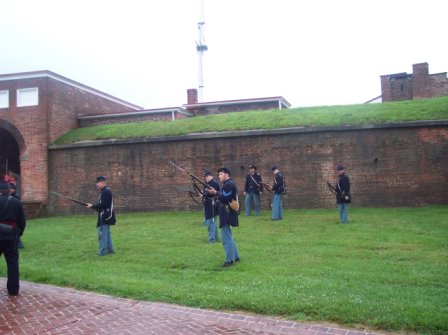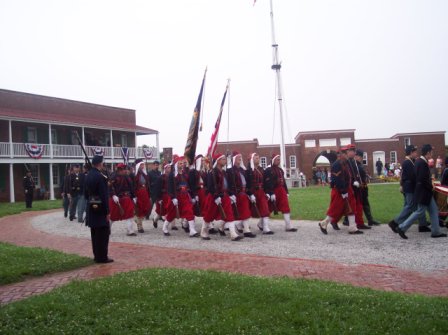Beautiful, bustling Baltimore.
Birthplace of "The Star-Spangled Banner."
Charm City.
Mob Town.
Mob Town?
Long before Baltimore adopted the nickname of Charm City in the 1970s, it was known as Mob Town. This goes back to at least the mid-1800s.
Rumors have it that encounters with the city's toughs led to Edgar Allan Poe's death in 1849. While traveling through Baltimore during a special election in early October of that year, he supposedly was dragged from voting station to voting station by a gang who got him liquored up, then dumped him outside a polling place, where some friends found him delirious. He died in a hospital a few days later.
In the presidential election of 1860, Maryland cast its electoral votes for the Southern Democrat John Breckinridge, an ardent pro-slavery, pro-South candidate, while Virginia supported John Bell, the Constitutional Party (middle of the road) candidate.
By 1861, Baltimore was an odd duck of a city. It was a major port of immigration, where mainly Germans and Irish came to find a new and freer way of life. Baltimore also was a city almost one-quarter black, the highest percentage of any major American city. Many were freedmen.
Although the city resembled Philadelphia and New York City as a Northern trading center - it was home base for one of the nation's greatest railroads, the B&O - the sympathies of much of its "genteel" class and ruffians were with the South, where one state after another was leaving the Union to join the Confederacy.
Things came to a boil in April. Fort Sumter in the Charleston, S.C., harbor had been fired upon by the Confederates, and President Lincoln had called for 75,000 volunteers to preserve the Union. But all rail traffic to Washington had to pass through Baltimore, which even Lincoln had to go through secretly in February on the journey to his inaugural.
The first troops to answer his call were the 6th Massachusetts Regiment. They arrived in Baltimore on April 19.
At that time, trains from the North came into President Street Station on the eastern edge of the Inner Harbor. No locomotives were allowed into the downtown. Trains had to be pulled by horse along Pratt Street about 12 blocks to Camden Station. Then the journey to Washington could continue.
No one had been killed by enemy fire at Fort Sumter. The same was not true for Baltimore. By the time the Massachusetts troops got to Camden Station, four soldiers were dead and 30 civilians had become casualties.
Lincoln, of course, recognized the importance of keeping Baltimore and Maryland in the Union. The president suspended the writ of habeas corpus while Gov. Thomas Hicks moved the Maryland Legislature to Frederick, where he was certain the lawmakers would vote to remain in the Union. By the end of the war, more than 40 Union military camps were arranged in and around Baltimore, making sure the population remained loyal.
All those camps are gone, except for Fort McHenry.
Anyone with even a smidgen of knowledge concerning American history knows that Fort McHenry was important during the War of 1812. While on a truce ship on the Patapsco River, Francis Scott Key wrote "The Defence of Fort McHenry," which was set to music (actually an English drinking song) and later became the national anthem.
What many people don't know is that the fort was occupied for military purposes into the 1920s, even serving as a hospital center for doughboys returning from World War I.
The configuration of the fort remains basically the same as it was during the Civil War, though a second story was added to the fort's buildings after the War of 1812. The guns guarding the fort are of Civil War vintage. By 1860, the fort had pretty much lost its use as a guardian of the harbor. (Fort Carroll farther out in the harbor, constructed in the late 1840s and early 1850s by an Army officer named Robert E. Lee, had taken its place.)
Fort McHenry was easily accessible by sea and was at the end of a peninsula leading toward downtown Baltimore. During the Civil War, the fort was to serve a multitude of purposes.
First and foremost, it was the place where Union troops could be stationed in case of trouble. Eventually, some of the largest guns and mortars were pointed not out toward the river but toward the city.
It was reported that a group of ladies with Southern sympathies once visited the fort. The commandant showed them around. They noticed that some of the guns were pointed toward town. These included the new Rodman guns, which could hurl 440-pound shells three miles. He asked them to follow the sight of the cannons and declared that he was ready to fire upon the Battle Monument, Washington Monument and any place where secessionists might be gathering. The ladies got his point.
Second, the fort was a place for those arrested as traitors and later for prisoners of war. Some early "guests" of the federal government were the mayor and police chief of Baltimore, who could not control the rioters on April 19.
The grandson of Maj. George Armistead, who had commanded the fort during the 1814 bombardment, was imprisoned for having a Confederate flag hidden in a carpetbag. Even the grandson of Francis Scott Key was held as a Southern sympathizer. He was the editor of the Daily Exchange, a decidedly pro-Confederate newspaper. Most POWs did not stay long, being quickly transferred to Delaware and Elmira, N.Y. (bitterly referred to as Helmira).
Third, thousands of wounded and captured Confederates were brought to the fort after the battles of Antietam in 1862 and Gettysburg in 1863. Although the fort was 70 miles away from the battles, the cannonading from them was heard as distant thunder.
 Since 1992, a re-enactment of a Civil War camp has taken place on the last weekend of April each year at Fort McHenry. This year was the 10th anniversary. The encampment was under the command of Garrison Commander Tom Downes, Infantry Commander William Hutchison and Cavalry Commander Tom Williams.
Since 1992, a re-enactment of a Civil War camp has taken place on the last weekend of April each year at Fort McHenry. This year was the 10th anniversary. The encampment was under the command of Garrison Commander Tom Downes, Infantry Commander William Hutchison and Cavalry Commander Tom Williams.
More than 100 re-enactors pitched their tents. The objective of the encampment is to provide visitors and participants the opportunity to experience and appreciate Fort McHenry's preservation and its role during the Civil War. This year's event was modeled after 1864, when many of the fort's wartime functions were in full bloom.
Two officers' ladies (Sherry Porter and Marty Riddell) led tour groups to the sundry points where various re-enactors explained their particular part of the encampment. One soldier explained the tents and various equipment an 1864 Union soldier would have. Another explained his cavalry unit and how carbine, saber, revolver and horse were used together as a fighting unit.
A gentleman explained the U.S. Christian Commission, which existed only during the Civil War but was the originator of many functions later taken on by the government, such as notifying next of kin in case of death, making sure personal effects were returned to the family and getting soldiers' pay sent home. It also provided special food (such as farina and tapioca) for recovering soldiers instead of the normal diet of salt meat and hard tack.
The Sanitary Commission, forerunner of the Red Cross, also was represented. A sutler also was on hand, selling canned goods and knickknacks the soldiers otherwise could not obtain. All of this took place outside the fort itself. Some troops were staying inside the fort, with even a "political prisoner" under the guard of the provost marshal.
In the afternoon, a combined arms demonstration was presented under the direction of "1st Lt." Jack Foley. He gave a running narration of the various types of shot used in a 6-pound cannon. (Always remember that 6 pounds refers to the weight of the shot, not the cannon.) Then the cannon was fired. A cavalry demonstration also was given. Then the infantry came in, firing at will. After that, the re-enactors spoke to the gathered crowd.
 The highlight of the afternoon was a dress parade and tattoo ceremony, in which Gail Stephens, a volunteer at the Monocacy National Battlefield near Frederick, Md., was made an honorary colonel and given the Ernest Peterkin Award. The award is conferred to someone who has made significant contributions to Civil War scholarship or battlefield preservation. She has written extensively on Lew Wallace (a Union general and later the author of "Ben-Hur") and continues to research the battle of Monocacy.
The highlight of the afternoon was a dress parade and tattoo ceremony, in which Gail Stephens, a volunteer at the Monocacy National Battlefield near Frederick, Md., was made an honorary colonel and given the Ernest Peterkin Award. The award is conferred to someone who has made significant contributions to Civil War scholarship or battlefield preservation. She has written extensively on Lew Wallace (a Union general and later the author of "Ben-Hur") and continues to research the battle of Monocacy.
Making sure all was running smoothly were park rangers Scott Sheads and Vince Vaise. Many groups provided support, including people from the President Street Station & Civil War Museum, the USS Constellation (last surviving wooden ship from the Civil War, which sent a contingent of its tars), and the National Museum of Civil War Medicine in Frederick, the Patriots of Fort McHenry, the Living Classrooms Foundation and Sons of Union Veterans of the Civil War. Many groups and individuals worked together to make this encampment a success.
Events at the historic fort are listed at www.nps.govfomc. The next encampment will be held during the last weekend of next April.
ē William Connery is a frequent contributor to the Civil War page of The Washington Times. He is available for personalized tours of historic sites in the Baltimore-Washington area and talks on the Civil War. He can be reached at william.connery@verizon.net.
 Since 1992, a re-enactment of a Civil War camp has taken place on the last weekend of April each year at Fort McHenry. This year was the 10th anniversary. The encampment was under the command of Garrison Commander Tom Downes, Infantry Commander William Hutchison and Cavalry Commander Tom Williams.
Since 1992, a re-enactment of a Civil War camp has taken place on the last weekend of April each year at Fort McHenry. This year was the 10th anniversary. The encampment was under the command of Garrison Commander Tom Downes, Infantry Commander William Hutchison and Cavalry Commander Tom Williams.
 The highlight of the afternoon was a dress parade and tattoo ceremony, in which Gail Stephens, a volunteer at the Monocacy National Battlefield near Frederick, Md., was made an honorary colonel and given the Ernest Peterkin Award. The award is conferred to someone who has made significant contributions to Civil War scholarship or battlefield preservation. She has written extensively on Lew Wallace (a Union general and later the author of "Ben-Hur") and continues to research the battle of Monocacy.
The highlight of the afternoon was a dress parade and tattoo ceremony, in which Gail Stephens, a volunteer at the Monocacy National Battlefield near Frederick, Md., was made an honorary colonel and given the Ernest Peterkin Award. The award is conferred to someone who has made significant contributions to Civil War scholarship or battlefield preservation. She has written extensively on Lew Wallace (a Union general and later the author of "Ben-Hur") and continues to research the battle of Monocacy.